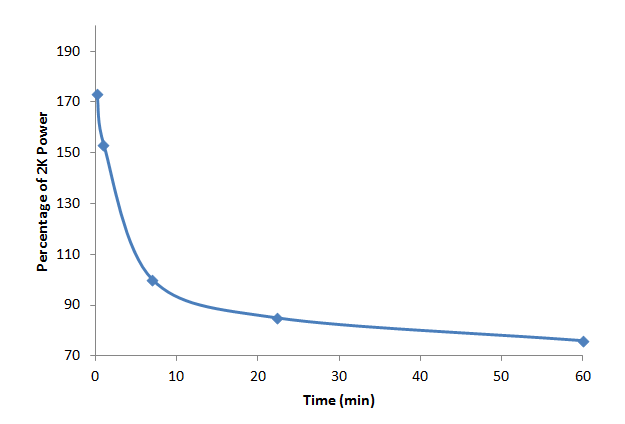Anyone who is following developments in the cycling world over the last few years will know that there are a number of cheap/easy to use automated training plans for cycling that were set up based on your FTP (functional threshold power). FTP is described as the maximum power that you can maintain for an hour of work which in cycling it was found that this was 95% of the maximum power you could do for 20 mins, so many sites built up training plans/bands using this idea – this was always hard to relate across to rowing because the ratio of “FTP” to 20mins is very different in rowing, there is no way I could maintain 95% of my 20min test power for an hour! This made it hard to use a site set up to automatically recommend a training plan as they are often the cheapest/easiest for people who are uncoached to get access to a training plan that is adapted to their own weaknesses.
Recently however several sites have started to talk about the fact that you are “more than your FTP” – recognizing that FTP isn’t the only part of your fitness profile, and so companies like of Xert and Sufferfest’s have begun to focus on the whole range of your fitness profile. Xert are doing this by analysing your training data and adjusting your training on the fly to ensure you are working out efficiently (read about it here, its very cool) but more interestingly in relating to rowing is how sufferfest are impletmenting the post FTP era by having you do a “Full Frontal” training plan where you do multiple tests in order to map out your profile and then comparing it to “ideals” it then adjusts your training plan to focus on your weaknesses
How does this cross over to rowing? Well a Danish Researcher Kurt Jensen has previously modeled the rowing “Golden curve” using data from the Danish National Squad which demonstrated the ideal relationship between the following tests:

- 10 second all out average power wattage was 173% of the 2k average power
- 60 seconds all out was 153% of the 2k average power wattage.
- 6k power was 85% of 2k average power
- 60 minute ‘hour of power’ average power wattage was 76% of 2k average power
This curve demonstrates what you should be hitting for each of the tests, if you are lower than one of the numbers then you know that that is an area where you need to improve (there are more details and a neat calculator here). If you read through the link to the Sufferfest Full Frontal you will notice that this is very similar to the types of test that Jensens curve was recommending.
With this in mind its easy to see how a rowing test methodology could be set up an automated training plan using Jensens Curve theory. Each rower would start with an average training plan using Polarised Training method (80:20 aerobic to High Intensity), but that would be automatically adjusted following the Jensen Tests to cater for the rowers individual area of weakness – i.e. if their 10 second power was down then more max watts workouts would be included, if their 60 min average wattage was down then the amount of Aerobic training would be increased. Tests could be set to be repeated every 2-3 months to reset the training to your areas of weakness – this idea is already used by the Australian squads testing protocol in parallel to the lactate testing as a cheaper/less time intensive way of testing more frequently, so it is known to work and so all that would be needed would be a way to automate this process on a site.
In theory then this would be one way of a site to be set up to give rowers a cost effective way of setting their own training plans that can automatically update over time as your fitness changes and target your own specific weaknesses over time.
Nice read. Looked up my numbers… the scaling (2k, 6k, 60‘) works pretty well for me. The shorter ones (1‘, 10“) not at all; but I‘m not a „sprinter“.
Yes I suspect I’d be the same!
I read about xert on athletictimemachine’s blog a couple of days ago and spent some time reading about it. These algorithmic plans seem really interesting, but I am wondering how much the difference between rowing and cycling could confound the algorithms. It seems as if xert is constantly trying to “adjust” my performance to fit a cyclists critical Power curve, that I would end up with a plan that is heavily biased. Cited the specific thing you said. On a bike, you can do about 95% of the power of a 20 minute test for an hour. On a rower, I’m working on the aerobic end of the training to can get to 90%. Wouldn’t the algorithm just push me to ever greater amounts of LSD?
Yes I don’t think xert could be used by a rower really, as you say the FTP is very different – reallly my point wasn’t so much to make a rowing XERT tho (although maybe eventually!) it was more using XERT and sufferfest to show that cyclists are looking to training plans that test for a range of tests, not just one (like FTP or a 2k) and it just struck me how rowing already had such a model with Jensen’s curve